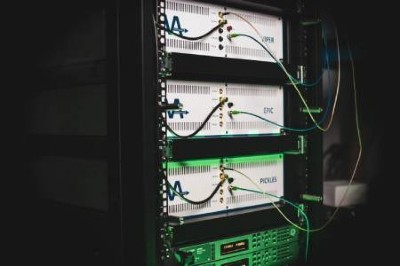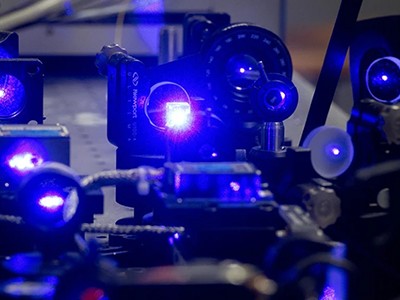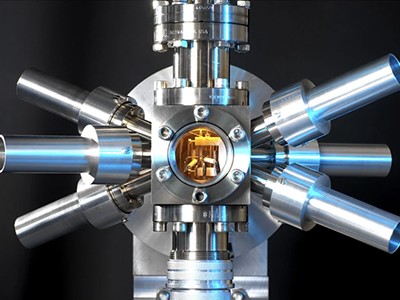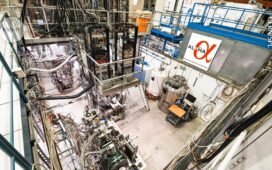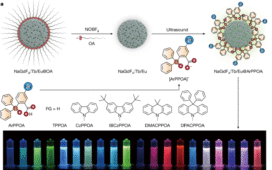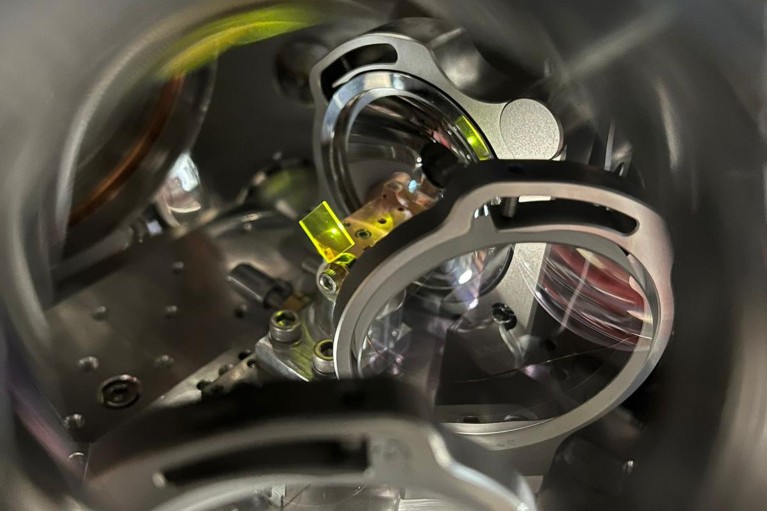
Researchers probed nuclei of thorium-229 embedded in a crystal — the small white disc near the centre of this image — using a laser device called a frequency comb.Credit: Ye Labs, JILA, NIST and Univ. Colorado
Physicists have demonstrated all the ingredients of a nuclear clock — a device that keeps time by measuring tiny energy shifts inside an atomic nucleus. Such clocks could lead to vast improvements in precision measurements, as well as new insights into fundamental physics.
Researchers measured the frequency of light that causes nuclei of the rare isotope thorium-229 to shift to a higher energy state — the ‘tick’ of the nuclear clock — with an accuracy that is 100,000 times greater than the previous best effort. They did this by synchronising the energy transition with the tick of the world’s most accurate clock. The work was led by Jun Ye at JILA, a research institute in Boulder, Colorado, and published in Nature on 5 September1. “It’s really one of the most exciting papers in recent times,” says Marianna Safronova, an atomic physicist at the University of Delaware in Newark.
Atomic clock keeps ultra-precise time aboard a rocking naval ship
The breakthrough came from probing thorium-229 nuclei with a laser device called a frequency comb. The set-up isn’t technically a clock, because it hasn’t been used to measure time. But such impressive results make the development of a nuclear clock seem possible, says Safronova.
Measurements of the tick are already proving useful in particle physics, says Elina Fuchs, a theoretical physicist at Leibniz University Hanover, Germany. And because the clock’s frequency is set by the fundamental forces that hold together the nucleus, the prototype could spot whether a type of dark matter — an invisible substance that accounts for around 85% of material in the Universe — affects these forces on a minuscule scale. “This is a new, direct window onto the nuclear force,” says Fuchs.
Ultimate timekeepers
The world’s best clocks, called atomic clocks, keep time using lasers — the light’s frequency honed precisely to match the energy it takes to move electrons between two energy levels inside an atom. The most accurate atomic clock gains or loses only one second every 40 billion years. A nuclear clock would work slightly differently: the tick would correspond to the energy transitions of protons and neutrons, rather than electrons, as they reshuffle into an excited state.
This energy shift requiresa slightly higher, ultraviolet frequency, resulting in a faster tick rate that could match or surpass the accuracy of the atomic clock. But the nuclear clock’s biggest potential advantage is the combination of precision and stability. Particles in the nucleus are less sensitive than electrons to disturbances such as electromagnetic fields — meaning that a nuclear clock could be portable and robust. “It becomes insensitive in a way that is kind of unthinkable in terms of how our clocks work today,” says Anne Curtis, an experimental physicist at the National Physical Laboratory in Teddington, UK.
Chinese team syncs clocks over record distance using lasers
But finding the right kind of atomic nucleus to use, and determining the frequency needed to induce its shift to a different energy state, has been a 50-year slog for physicists. In the 1970s, indirect evidence suggested that thorium-229 had a bizarrely low-energy nuclear transition2 — one that might eventually be triggered by tabletop lasers. But it wasn’t until last year that scientists discovered the required frequency3 — and this year, they successfully initiated shift with a laser4.
The JILA team looked for the transition frequency in trillions of thorium-229 atoms embedded in a crystal using a system known as a frequency comb. The comb pumps out an array of laser frequency lines, with regular and even spacing. It allows researchers to illuminate the crystal with many precise frequencies at once to look for a match, rather than scanning laboriously through the range of possible options using a single-frequency laser.
The comb’s settings — including the width of the gaps between the lines, or ‘teeth’ — were calibrated using the atomic clock and could be tweaked. The team conducted several experimental runs, and when they observed the tell-tale glow produced when thorium-229 atoms decay from their excited state, they used the settings to calculate the frequency driving the signal.
Observing the transition for the first time “felt amazing”, says study co-author Chuankun Zhang, a physicist at JILA. “We spent the entire night doing all the tests to check if this is actually really the signal that we were looking for,” he says.
Fundamental forces
The magic of the frequency comb is that it enables physicists to measure the frequency tick of one clock — here of the thorium-229 nucleus — as a ratio of another known frequency in this case of an atomic clock. This not only allowed the team to determine the absolute frequency value with high precision, but also opened up some cool possibilities in physics, says Zhang.
If the tick speed of one clock changes over time relative to the other, this could indicate that factors that determine the energy levels — such the strong nuclear or electromagnetic force — are drifting or wobbling, says Fuchs. Certain ‘light’ forms of dark matter, which have an extremely low mass, are predicted to have this effect, she says.
Best ever clocks: breakthrough paves way for ultra-precise ‘nuclear’ timekeepers
Any change in the forces would be amplified in the nuclear transition frequency, making nuclear clocks potentially about 100 million times more sensitive than atomic ones to the effects of this kind of dark matter. The latest result — which pinpoints the frequency with an accuracy of 13 decimal places — is already precise enough to narrow down the possible energy ranges in which light dark matter could exist, says Fuchs. Nuclear physics could also benefit from the more precise transition frequency, which could help scientists to distinguish betweendifferent possible shapes of the throrium-229 nucleus, she adds.
But more work must be done before nuclear clocks can outperform atomic ones — which are currently accurate to 19 decimal places. Researchers will explore whether keeping thorium-229 embedded in a crystal — a solid state is handy for making a portable clock — will make for the most accurate timekeeper, or whether trapping individual atoms will yield better results.
The laser system also needs honing. “Fortunately, this amazing technique has high potential,” says Olga Kocharovskaya, a physicist at Texas A&M University in College Station. It’s a “prototype of the source to be used in the future clock”, she adds.


